Anxiety is a natural response – think fight, flight, or freeze whenever we feel threatened or uneasy about a situation – and everyone can experience this at some point or another. It can be useful in helping us to avoid dangerous situations, and can even motivate us to do better, or be better.
It’s normal to experience anxiety.
Like many mental health conditions, anxiety can range in severity from mild to severe.
A mild case could be described as feeling uneasy or apprehensive about something (butterflies in the stomach before you go on stage, delivering a training course, or even attending an interview), whilst on the other end of the scale, a full-scale panic attack would be considered severe.
The duration of how long an episode of anxiety lasts can differ greatly – from a few moments to many years.
The thing is, moderate to severe anxiety could have been your ‘normal’ for years and it’s just a part of your everyday life!
Anxiety becomes a ‘disorder’ when:
- It’s more severe
- It’s long-lasting
- It interferes with a person’s life – eg work, and/or relationships
Since Covid-19 entered our lives, it’s fair to say that many of us will have experienced anxiety at some stage for one reason or another – and the media won’t have helped with that – from reported food shortages, medication supply issues, cancelled hospital appointments, the list goes on!
We’re also now entering a period of time where restrictions have been relaxed further, for instance, the wearing of masks is now optional when out and about, and guest numbers for weddings and funerals has been increased – increasing the risk of transmission between people again.
Part of the relaxation roadmap includes workers being recalled back to the workplace and that could include people with underlying health conditions that make them more susceptible or vulnerable to viruses ….
How anxious do you think they are right now? Yesterday they were isolating, tomorrow they’re expected back in work where social distancing might not be as strict, mask wearing might be non-existent, cold and flu season is just around the corner. You get the idea.
As an employer it’s worth exploring options with each worker to determine what would work well for your business, and their individual situation. Clear and open communication is key to reaching a workable solution.
The solution could be for the employee to continue working from home, return to work fully, or maybe it’s possible to offer a hybrid working scenario?
That’s what any good employer would do. (The better employer would also keep a record of the discussion in order to demonstrate compliance with their legal obligations under the Consultation with Employees Regulations!)
Please bear in mind that throughout all this that where a workplace is concerned, the general health and safety responsibilities and legal duties remain intact for both employers and workers. Keep an eye on those risk assessments – especially if you make any changes to the working arrangements in your business!
How can I tell if someone’s anxious?
There will be physical, psychological and behavioural signs to look out for.
A word of warning though, some of the physical signs could easily be confused for a heart attack! Be careful here! If in any doubt, always phone 999 or 112 (the international emergency contact number) for an ambulance. Better to be safe than sorry.
Physical signs could include:
- Hyperventilation, shortness of breath
- Dizziness, headache, sweating
- Muscle aches and pains, restlessness, tremors and shaking
Psychological signs to look out for could include:
- Excessive fear and worry
- Decreased concentration and memory
- Restlessness or feeling “on-edge”
- Tiredness, disturbed sleep
Behavioural signs to keep an eye out for include:
- Avoidance of situations, locations, or people
- Distress
- phobic behaviours – urges to escape situations eg crowded places, confined, or enclosed spaces
How anxious are you? – The Goldberg Scale
As part of a wider medical assessment, the following questions are used to test the level of anxiety experienced by an individual. It can be a useful self-assessment tool when used regularly.
Answer the following questions, and award yourself 1 point when the answer is Yes. (When you get to question 7, you don’t need to award yourself 1 point for everything listed!)
So, in the past month…..
- Have you felt keyed up or on edge?
- Have you been worrying a lot?
- Have you been irritable?
- Have you had any difficulty relaxing?
- Have you been sleeping poorly?
- Have you had headaches or neck aches?
- Have you had any of the following: trembling, tingling, dizzy spells, sweating, urinary frequency, or diarrhoea?
- Have you been worried about your health?
- Have you had difficulty falling asleep?
Ok, now add up your score.
The average score for adults is 4.
The higher the score, the more likely you’ll experience some disruption to your daily life.
NOTE: A high score may not mean that you have an anxiety disorder – maybe it’s just a stressful or exciting time for you at the moment (you’ll know better than anyone).
If you are concerned, go and see your GP or make an appointment to speak with your Occupational Health department at work.
If it makes you feel any better, 12% of adults score 8 or more on this scale. Remember this does not mean you have a disorder.
If you’re interested in learning more about anxiety and other mental health conditions, including more about self-help or self-care, then why not become a certified Mental Health First Aider with us? You can find out more by visiting our webpage.
Self-Help or Coping Strategies
Like many mental ailments, the good news is that anxiety can be managed and instances of panic attacks can be reduced.
Self-help strategies can be an important part of the recovery process and can also help people feel like they’re regaining control of their lives.
Because everybody is different (and so are their challenges and experiences), there will never be a one-size-fits-all solution.
Our recommendation is to approach it like you would approach a buffet table.
Imagine a long table set out in front of you with many plates. Each plate has a different kind of food on it. No two plates are the same. You’re not going to like everything on offer. The more adventurous of us out there will try a variety of foods.
Sample everything until you find what works for you.
Maybe the first thing you try works straight away, or maybe it will be a combination of a few things over weeks or months.
Maybe nothing will work right now because you’re not ready for it to work. This could be a case of you not being ready to make the commitment to getting better, or you don’t have the time or energy just now.
And that’s ok, take your time. The resources will still be there when you’re ready.
To make any change in life, you’ve got to want the change, and you’ve got to put in the necessary time and effort before you start seeing results. And when you start getting results, stick with it for a few more months until it becomes an automatic habit.
Always bear in mind that you may need to use self-help in conjunction with medical treatments. If you can get better without medication, then that would be fantastic!
Remember asking for help is a sign of strength. It means you’re ready to start getting better.
Here are some options/resources on the buffet table worth exploring:
- Anxiety is best overcome by confronting fears head-on
- Read or listen to self-help books, or listen to podcasts specifically dealing with anxiety
- Reduce caffeine intake, or better still, avoid it completely
- Take regular exercise
- Engage in activities you enjoy. Go! Have fun!
- Try cognitive behaviour therapy (CBT) www.getselfhelp.co.uk
- Practice mindfulness – being present in the moment. Grounding yourself. www.headspace.com
- Learn more about anxiety www.anxietyuk.org.uk
If you or someone you know is struggling with their mental health and you’d like to learn how to help yourself or them, why not become a certified mental health first aider? We run courses regularly – online and classroom – and we welcome anyone aged 16 or over on our Adult 2 Day course.
To find out more or to book your place click here.
We also provide health & wellbeing management system services to a range of businesses across the UK so before you spend money and waste time on unnecessary workplace “initiatives”, let’s discover what you actually need through our 100% confidential and unbiased health & wellbeing survey. Click here for more information.

